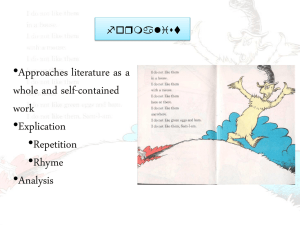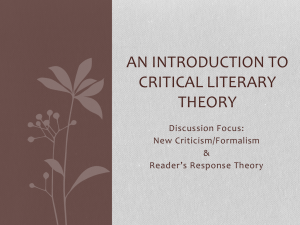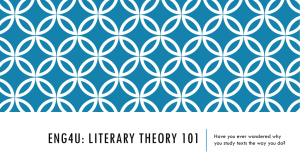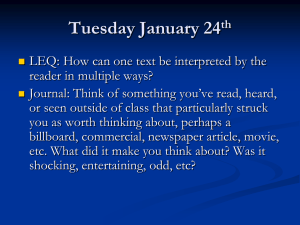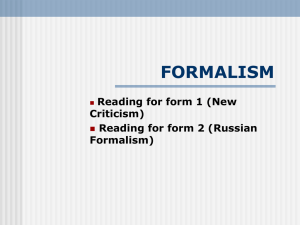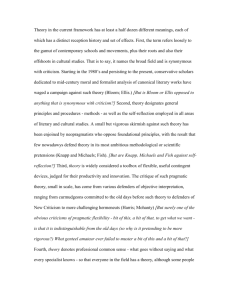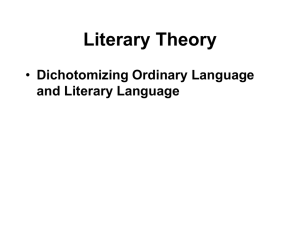File critical theory
advertisement
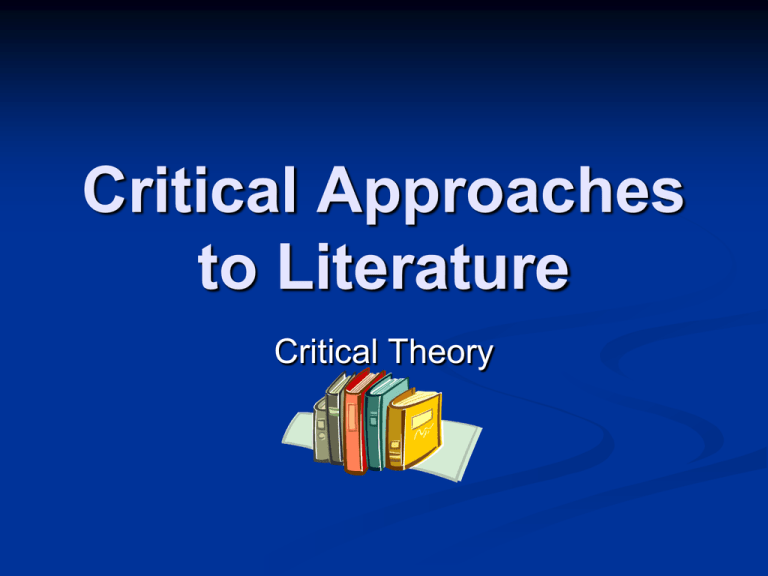
Critical Approaches to Literature Critical Theory Introduction Formed during the 20th century to develop the study of literature as a discipline All critical approaches ask some fundamental questions: What is literature? What does it do? What is literature’s primary purpose? In addition to expressing ideas, what else does literature do? How does it contribute to artistic, political and social thought and history? Introduction None of these theories reflect “the way” to study literature; they reflect major tendencies not absolute straight-jacketing. Some critics may consider themselves Feminist Theorists but utilize strategies from New Criticism. In other words, literary criticism is pragmatic or eclectic rather than rigid Why study the theories? To help develop your own capacities as a reader and a writer To expand the lens you use to analyze literature Types Of Critical Approaches Moral/Intellectual Topical/Historical New Critical/Formalist Structuralism Feminist Criticism/Gender Studies Queer Theory Marxist Psychological/Psychoanalytical Archetypical/Symbolic/Mythic Deconstruction New Historicism Reader Response Post-Colonialism Race Theory Topical/Historical Stresses the relationship between literature and its historical period Although great literature often applies to various time periods, much of it also directly reflects the intellectual and social worlds of their authors. This approach investigates author’s biographies, concepts and words that today’s reader may not immediately understand. This approach requires the theorist to utilize footnotes, dictionaries, historical references, and other reference materials. Historical Cont A common criticism of the historical/topical approach is that in the extreme, it deals with background knowledge rather than the literature itself. New Historicism A reaction against Historical Criticism The New Historicist justifies the parallel reading of both literary and non literary works in other to form an informed understanding of the context of the literary work. This approach assumes that history is not a “fixed” essence but a literary construction Combining the history with literary understanding readers must achieve a deeper understanding of the literature Formalism/Structuralism Also known as New Criticism, the Formalist focuses on literary texts as formal works of art. The Formalist examines the meanings of literature; asking the questions: what does a work say? And How well is it said. A major idea in this approach is that all the contents of the work, including its subtleties, ideas, ambiguities and contradictions were in the conscious or subconscious of the author. There are no accidents. Finds relationships between things that seem to be separate and unique Enables critics to study literature from a variety of cultures and historical periods Focuses on a comprehensiveness of description Best when utilized for larger texts Examples: “My Last Duchess” Formalism The text is termed a dramatic monologue because it contains three formal elements- an occasion a speaker and a hearer. The inflexible format is deceptive creating the contrast between obsessive, psychological dysfunction and power. The utilization of iambic pentameter and couplets clarify the Duke’s insanity in the face of frightening control. Historical Browning lived in Italy thus creating a sense of authenticity to the poem. New Historicism The use of the artists’ names and the titles of the artwork add a sense of verisimilitude (reality). Browning utilizes his knowledge of the Renaissance to create a reality which emphasizes The Duke’s insanity. More Definitions Deconstruction Reader Response A strategy not an approach for reading Developed by Jacques Derrida These theorists assume the instability of language They criticize Western assumptions that speech is a direct expression of the speaker’s intention, a direct correspondence to reality. Standard deconstruction may begin with a traditional reading/ interpretation of the text and then rip it apart in order to form a new understanding Another deconstructionist approach is to examine the text in light of gaps, or missing elements or even words or phrases with multiple interpretations Rooted in phenomenology; a philosophy that is rooted in how things appear Thus the quest for truth in the world is to be found not in the external world but in our perception and interpretation of the external signals Reader Response theorists believe that the text is not complete until readers make a transaction with it by assimilating it and intertwining with their own knowledge and experience This theory supports continual learning-the more I learn about art, politics, science, history, the more I will bring to the text Questions: What does this work mean to me? How can the work widen my insights? What knowledge do I need to acquire to deepen my understanding of the text? Examples Reader Response/Deconstruction The use of false names for the artists, that sound like actual Renaissance artists, emphasizes the Duke’s arrogance and reminds the reader of the large social gap between the aristocracy and peasantry at this time (Reader Response) The reader assumes that the emissary is shocked, appalled by the Duke’s “accidental” confessions. But, what if the Duke actually meant his confessions as a warning to his new duchess and what if the emissary is not shocked; instead expects this behavior.. (Deconstruction) There is no emissary, this is not a dramatic situation but rather a just the insane ramblings of warped mind. (Deconstruction) Developed in the 1920’s; known as an American movement Advocates “close” reading of text instead of overwhelming concern for context and history Generally applied to poetry; encourages textual analysis rather than an exploration of poet’s life or social implications Example: The Duke repeatedly refers to the Count’s emissary as “Sir” indicates the Duke’s belief that the envoy understands, maybe even shares the Duke’s aberrant feelings. Post Modernism Applies to several fields: philosophy, art, literature, architecture, history, etc. Skepticism to modern ideals Communication shaped by cultural bias, myth, etc. Meaning and experience created by individual, cannot be made objective by an author or narrator Methodologies Though postmodernism is “an attack against theory and methodology”, it uses two methods Deconstruction Intuitive Interpretation Post Modernist Formula developed by Chip Morningstar Select a work to be deconstructed Decide what the text says Identify within the reading a distinction Convert into a hierarchical opposition Derive another self-referential reading of the text Decide Meaning Example “Reading Poems in Public” by Maurice Kenney Discusses the lack of an audience for his reviving of Indian heritage Criticism of American self-centeredness and ignorance Is a desperate plea and a scathing assault Identify a Distinction and Hierarchical Opposition Distinction: “hear” versus “listen” Not explicit, but can be implied Evident in the fact that an audience is present, but questions are so inane Hierarchical opposition Point out that one of the two terms is inherently more revered or accepted “Listen” valued more than “hear” Interpretation (basic) One cannot listen without being able to hear, thus the arbitrary hierarchy established by the text is invalid, and the actions of the audience in the poem cannot be construed as reprehensible or evil. Kenny would not have an audience at all without these Americans, and thus cannot criticize them. They are doing enough by hearing his poems, regardless of their interpretations. Feminist Criticism Gender Studies Queer Theory The Examine Examines overarching purpose is to question the traditional canon and claim a place in it for neglected women writers To delineate the ways both male and female characters are portrayed in literature, looking at how societal norms about sexual differences are either enforced or subverted in literature Close examination of patriarchal structures and institutions such as marriage. Explore issues of the “feminine mystique” and traditional roles assigned to women the social divide between the masculine and the feminine Explore Patriarchal structures and representations how homosexuals are portrayed in literature Examines veiled references to homosexuality in literature Archetypical Archetypal Criticism is closely related to Psychological Criticism but focuses on the work of Jung rather than Freud Presupposes that human life is built up of patterns or archetypes that are similar throughout various cultures and historical times. The best literature is grounded in archetypal patterns ?--How does this text fit into any archetypal structure? How closely does it fit the archetype/ What variations exist? What meaning(s) do the connections have? Examples: The creation; the hero’s journey/quest, the hero’s sacrifice Humanity’s search for paradise or perfection Many critics deride this approach because of Jung’s belief in a universal human consciousness, (all humans retain in their inner psyche a type of awareness for all that has come before and will come again) but they nevertheless consider this criticism important for comparisons and contrasts Initiation, young man discovers the power of literature, falling in love despite a need for independence are all patterns that occur across cultures and timelines Psychological Theory Focuses on Freud’s theories; utilizing his ideas of human behavior caused by hidden human motives Freud’s theories has had a profound impact on all intellectual disciplines and all post-Freudian literature Example: An exploration of character; Hamlet suffering an Oedipus complex. An exploration of the author’s motivation; Coleridge’s neuroses and its effect on “Kubla Khan” Questions What are the obvious and hidden motives that cause a character’s behavior? How much background does the author reveal about a character? (repressed childhood trauma, adolescent experiences and memories) How much is important in the analysis and understanding of the character Race Theory and PostColonial Theory
